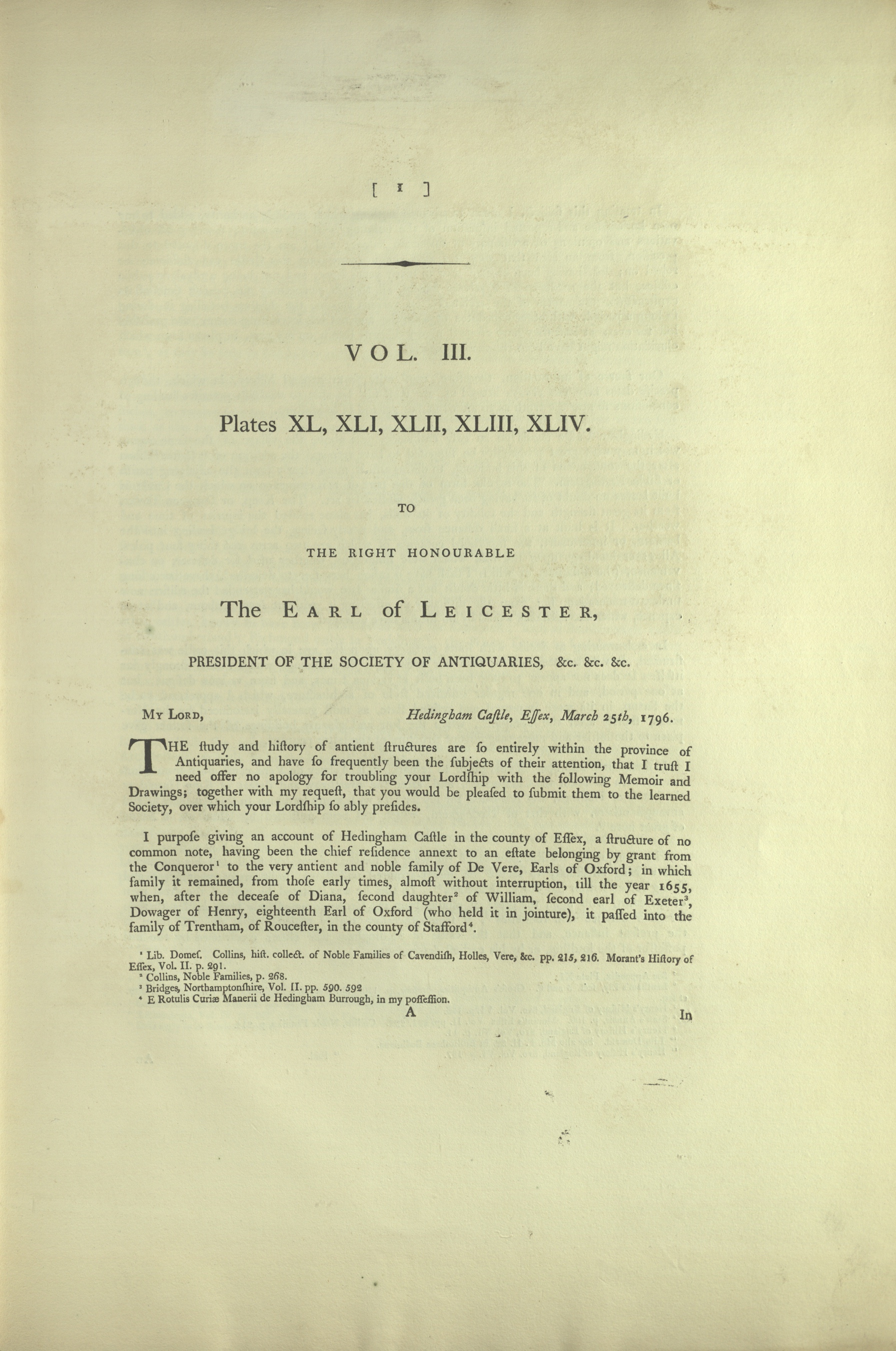
[ (Page) 1 ]
VOL. III. Plates XL, XLI, XLII, XLIII, XLIV.
TO THE RIGHT HONOURABLE THE EARL OF LEICESTER, PRESIDENT OF THE SOCIETY OF ANTIQUARIES, &. &c. &c.
Hedingham Castle, Essex, March 25th, 1796.
MY LORD,
THE study and history of antient structures are so entirely within the province of Antiquaries, and have so frequently been the subjects of their attention, that I trust I need offer no apology for troubling your Lordship with the following Memoir and Drawings; together with my request, that you would be pleased to submit them to the learned Society, over which your Lordship so ably presides.
Read more/less…
I purpose giving an account of Hedingham Castle in the county of Essex, a structure of no common note, having been the chief residence annext to an estate belonging by grant from the Conqueror1 to the very antient and noble family of De Vere, Earls of Oxford; in which family it remained, from those early times, almost without interruption, till the year 1655, when, after the decease of Diana, second daughter2 of William, second earl of Exeter3, Dowager of Henry, eighteenth Earl of Oxford (who held it in jointure), it passed into the family of Trentham, of Roucester, in the county of Stafford4.
1Lib. Domes. Collins, hist. collect. of Noble Families of Cavendish, Holles, Vere, &c. pp. 215, 216. Morant’s History of Essex, Vol. II. p. 291.
2Collins, Noble Families, p. 268.
3Bridges, Northamptonshire, Vol. II. p. 590. 592[.]
4E Rotulis Curiae Manerii de Hedingham Burrough, in my possession.
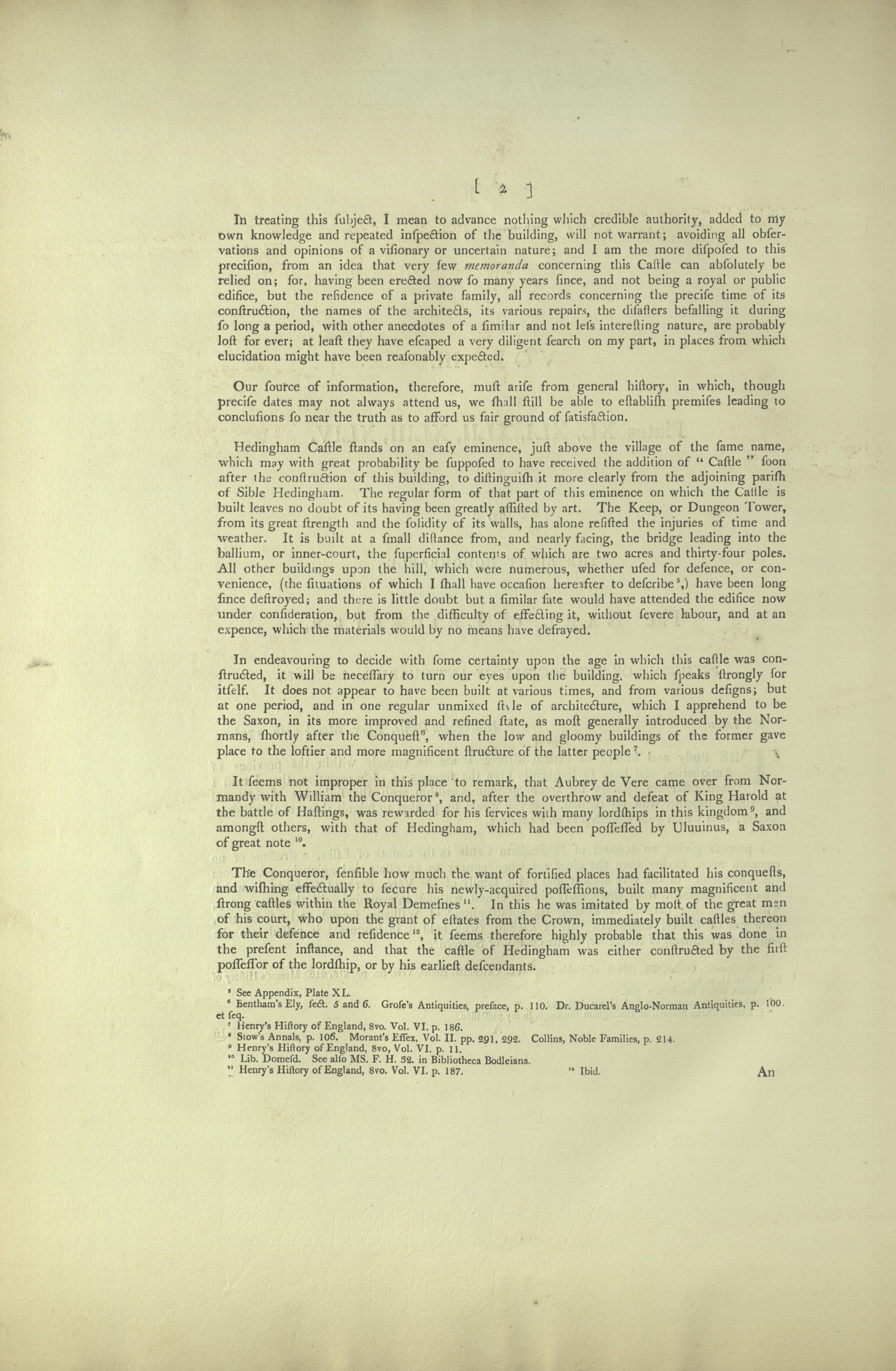
[ (Page) 2 ]
In treating this subject, I mean to advance nothing which credible authority, added to my own knowledge and repeated inspection of the building, will not warrant; avoiding all observations and opinions of a visionary or uncertain nature; and I am the more disposed to this precision, from an idea that very few memoranda concerning this Castle can absolutely be relied on; for, having been erected now so many years since, and not being a royal or public edifice, but the residence of a private family, all records concerning the precise time of its construction, the names of the architects, its various repairs, the disasters befalling it during so long a period, with other anecdotes of a similar and not less interesting nature, are probably lost for ever; at least they have escaped a very diligent search on my part, in places from which elucidation might have been reasonably expected.
Read more/less…
Our source of information, therefore, must arise from general history, in which, though precise dates may not always attend us, we shall still be able to establish premises leading to conclusions so near the truth as to afford us fair ground of satisfaction.
Hedingham Castle stands on an easy eminence, just above the village of the same name, which may with great probability be supposed to have received the addition of “Castle” soon after the construction of this building, to distinguish it more clearly from the adjoining parish of Sible Hedingham. The regular form of that part of this eminence on which the Castle is built leaves no doubt of its having been greatly assisted by art. The Keep, of Dungeon Tower, from its great strength and the solidarity of its walls, has alone resisted the injuries of time and weather. It is built at a small distance from, and nearly facing, the bridge leading into the ballium, or inner-court, the superficial contents of which are two acres and thirty-four poles. All other buildings upon the hill, which were numerous, whether used for defence, or convenience, (the situations of which I shall have occasion hereafter to describe5,) have been long since destroyed; and there is little doubt but a similar fate would have attended the edifice now under consideration, but from the difficulty of effecting it, without sever labour, and at an expence, which the materials would by no means have defrayed.
In endeavouring to decide with some certainty upon the age in which this castle was constructed, it will be necessary to turn our eyes upon the building, which speaks strongly for itself. It does not appear to have been built at various times, and from various designs; but at one period, and in one regular unmixed style of architecture, which I apprehend to be the Saxon, in its more improved and refined state, as most generally introduced by the Normans, shortly after the Conquest6, when the low and gloomy buildings of the former gave place to the loftier and more magnificent structure of the latter people7.
It seems not improper in this place to remark, that Aubrey de Vere came over from Normandy with William the Conqueror8, and, after the overthrow and defeat of King Harold at the battle of Hastings, was rewarded for his services with many lordships in this kingdom9, and amongst others, with that of Hedingham, which had been possessed by Uluuinus, a Saxon of great note10.
The Conqueror, sensible how much the want of fortified places had facilitated his conquests, and wishing effectually to secure his newly-acquired possessions, built many magnificent and strong castles within the Royal Demesnes11. In this he was imitated by most of the great men of his court, who upon the grant of estates from the Crown, immediately built castles thereon for their defence and residence12, it seems therefore highly probable that this was done in the present instance, and that the castle of Hedingham was either constructed by the first possessor of the lordship, or by his earliest descendants.
5See Appendix, Plate XL.
6Bentham’s Ely, sect. 5 and 6. Grose’s Antiquities, preface, p. 110. Dr. Ducarel’s Anglo-Norman Antiquities, p. 100. et seq.
7Henry’s History of England, 8vo. Vol. VI. p. 186.
8Stow’s Annals, p. 106. Morant’s Essex, Vol. II. pp. 291, 292. Collins, Noble Families, p. 214.
9Henry’s History of England, 8vo, Vol. VI. p. 11.
10Lib. Domesd. See also MS. F. H. 32. in Bibliotheca Bodleiana.
11Henry’s History of England, 8vo. Vol. VI. p. 187.
12Ibid.
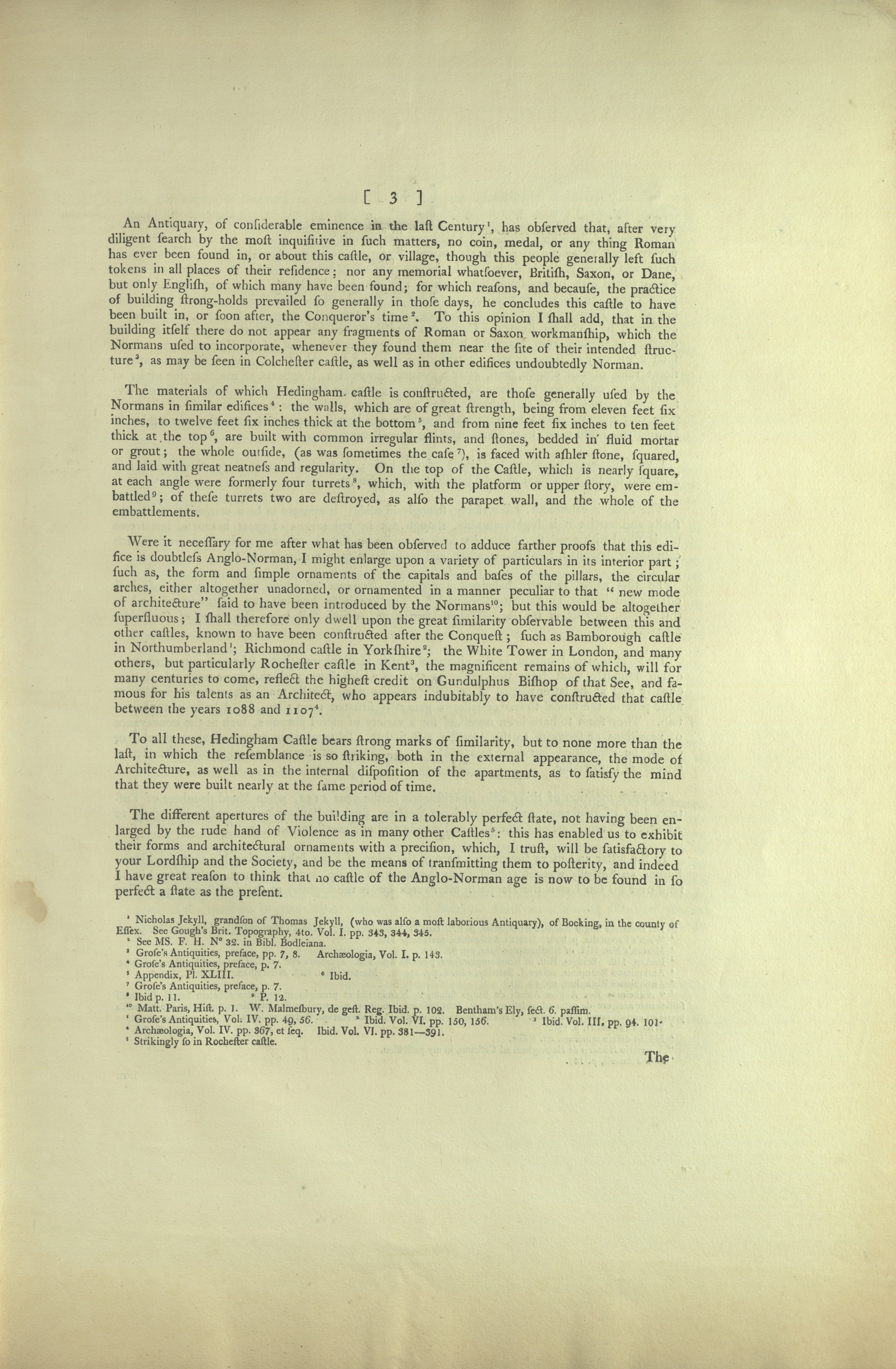
[ (Page) 3 ]
An Antiquary, of considerable eminence in the last Century1, has observed that, after very diligent search by the most inquisitive in such matters, no coin, medal, or any thing Roman has ever been found in, or about this castle, or village, though this people generally left such tokens in all places of their residence; nor any memorial whatsoever, British, Saxon, or Dane, but only English, of which many have been found; for which reasons, and because, the practice of building strong-holds prevailed so generally in those days, he concludes this castle to have been built in, or soon after, the Conqueror’s time2.
Read more/less…To this opinion I shall add, that in the building itself there do not appear any fragments of Roman or Saxon workmanship, which the Normans used to incorporate, whenever they found them near the site of their intended structure3, as may be seen in Colchester castle, as well as in other edifices undoubtedly Norman.
The materials of which Hedingham castle is constructed, are those generally used by the Normans in similar edifices4: the walls, which are of great strength, being from eleven feet six inches, to twelve feet six inches thick at the bottom5, and from nine feet six inches to ten feet thick at the top6, are built with common irregular flints, and stones, bedded in fluid mortar or grout; the whole outside, (as was sometimes the case7), is faced with ashler stone, squared, and laid with great neatness and regularity. On the top of the Castle, which is nearly square, at each angle were formerly four turrets8, which, with the platform or upper story, were embattled9; of these turrets two are destroyed, as also the parapet wall, and the whole of the embattlements.
Were it necessary for me after what has been observed to adduce farther proofs that this edifice is doubtless Anglo-Norman, I might enlarge upon a variety of particulars in its interior part; such as, the form and simple ornaments of the capitals and bases of the pillars, the circular arches, either altogether unadorned, or ornamented in a manner peculiar to that “new mode of architecture” said to have been introduced by the Normans10; but this would be altogether superfluous; I shall therefore only dwell upon the great similarity observable between this and other castles, known to have been constructed after the Conquest; such as Bamborough castle in Northumberland1; Richmond castle in Yorkshire2; the White Tower in London, and many others, but particularly Rochester castle in Kent3, the magnificent remains of which, will for many centuries to come, reflect the highest credit on Gundulphus Bishop of that See, and famous for his talents as an Architect, who appears indubitably to have constructed that castle between the years 1088 and 11074.
To all these, Hedingham Castle bears strong marks of similarity, but to none more than the last, in which the resemblance is so striking, both in the external appearance, the mode of Architecture, as well as in the internal disposition of the apartments, as to satisfy the mind that they were built nearly at the same period of time.
The different apertures of the building are in a tolerably perfect state, not having been enlarged by the rude hand of Violence as in many other Castles5: this has enabled us to exhibit their forms and architectural ornaments with a precision, which, I trust, will be satisfactory to your Lordship and the Society, and be the means of transmitting them to posterity, and indeed I have great reason to think that no castle of the Anglo-Norman age is now to be found in so perfect a state as the present.
1Nicholas Jekyll, grandson of Thomas Jekyll, (who was also a most laborious Antiquary), of Bocking, in the county of Essex. See Gough’s Brit. Topography, 4to. Vol. I. pp. 343, 344, 345.
2See MS. F. H. No 32. in Bibl. Bodleiana.
3Grose’s Antiquities, preface, pp. 7, 8. Archaeologia, Vol. I. p. 143.
4Grose’s Antiquities, preface, p. 7.
5Appendix, Pl. XLIII.
6Ibid.
7Grose’s Antiquities, preface, p. 7.
8Ibid[.] p. 11.
9P. 12.
10Matt. Paris, Hist. p. 1. W. Malmesbury, de gest. Reg. Ibid. p. 102. Bentham’s Ely, sect. 6. passim.
1Grose’s Antiquities, Vol. IV. pp. 49, 56.
2Ibid. Vol. VI. pp. 150, 156.
3Ibid. Vol. III. p. 94. 101.
4Archaeologia, Vol. IV. pp. 376, et seq. Ibid. Vol. VI. pp. 381—391.
5Strikingly so in Rochester castle.
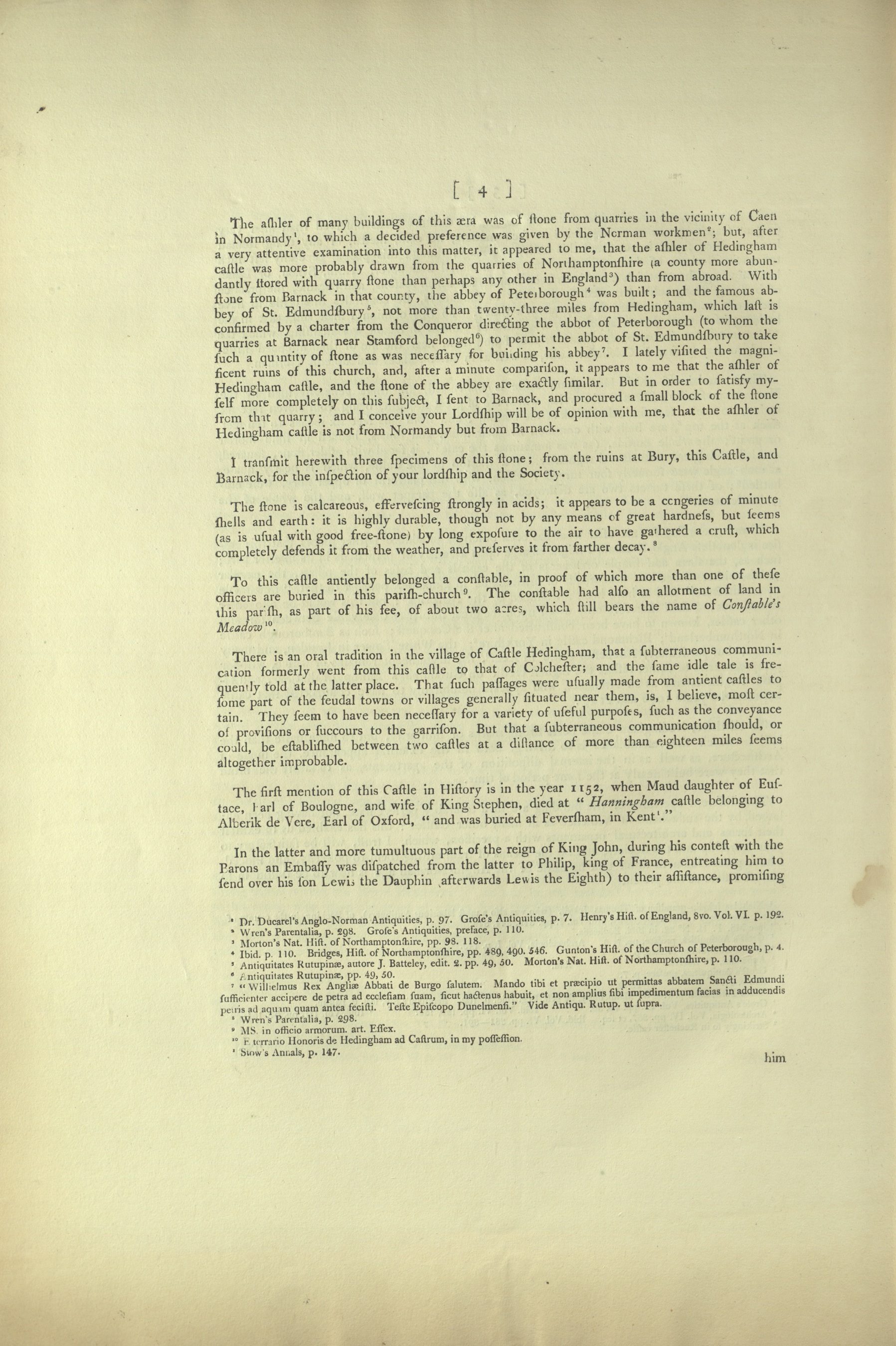
[ (Page) 4 ]
The ashler of many buildings of this aera was of stone from quarries in the vicinity of Caen in Normandy1, to which a decided preference was given by the Norman workmen2; but, after a very attentive examination into this matter, it appeared to me, that the ashler of Hedingham castle was more probably drawn from the quarries of Northamptonshire (a county more abundantly stored with quarry stone than perhaps any other in England3) than from abroad.
Read more/less…With stone from Barnack in that county, the abbey of Peterborough4 was built; and the famous abbey of St. Edmundsbury5, not more than twenty-three miles from Hedingham, which last is confirmed by a charter from the Conqueror directing the abbot of Peterborough (to whom the quarries at Barnack near Stamford belonged6) to permit the abbot of St. Edmundsbury to take such a quantity of stone as was necessary for building his abbey7. I lately visited the magnificent ruins of this church, and, after a minute comparison, it appears to me that the ashler of Hedingham castle, and the stone of the abbey are exactly similar. But in order to satisfy myself more completely on this subject, I sent to Barnack, and procured a small block of the stone from that quarry; and I conceive your Lordship will be of opinion with me, that the ashler of Hedingham castle is not from Normandy but from Barnack.
I transmit herewith three specimens of this stone; from the ruins at Bury, this Castle, and Barnack, for the inspection of your lordship and the Society.
The stone is calcareous, effervescing strongly in acids; it appears to be a congeries of minute shells and earth: it is highly durable, though not by any means of great hardness, but seems (as is usual with good free-stone) by long exposure to the air to have gathered a crust, which completely defends it from the weather, and preserves it from farther decay.8
To this castle antiently belonged a constable, in proof of which more than one of these officers are buried in this parish-church9. The constable had also an allotment of land in this parish, as part of his see, of about two acres, which still bears the name of Constable’s Meadow10.
There is an oral tradition in the village of Castle Hedingham, that a subterraneous communication formerly went from this castle to that of Colchester; and the same idle tale is frequently told at the latter place. That such passages were usually made from antient castles to some part of the feudal towns or villages generally situated near them, is, I believe, most certain. They seem to have been necessary for a variety of useful purposes, such as the conveyance of provisions or succours to the garrison. But that a subterraneous communication should, or could, be established between two castles at a distance of more than eighteen miles seems altogether improbable.
The first mention of this Castle in History is in the year 1152, when Maud daughter of Eustace, Earl of Boulogne, and wife of King Stephen, died at “Hanningham castle belonging to Alberik de Vere, Earl of Oxford, [and] was buried at Feversham, in Kent1.”
In the latter and more tumultuous part of the reign of King John, during his contest with the Barons an Embassy was dispatched from the latter to Philip, king of France, entreating him to send over his son Lewis the Dauphin [(]afterwards Lewis the Eighth) to their assistance, promising
1Dr. Ducarel’s Anglo-Norman Antiquities, p. 97. Grose’s Antiquities, p. 7. Henry’s Hist. of England, 8vo. Vol. VI. p. 192.
2Wren’s Parentalia, p. 298. Grose’s Antiquities, preface, p. 110.
3Morton’s Nat. Hist. of Northamptonshire, pp. 98. 118.
4Ibid. p. 110. Bridges, Hist. of Northamptonshire, pp. 489, 490. 546. Gunton’s Hist. of the Church of Peterborough, p. 4.
5Antiquitates Rutupinae, autore J. Batteley, edit. 2. pp. 49, 50. Morton’s Nat. Hist. of Northamptonshire, p. 110.
6Antiqruitates Rutupinae, pp. 49, 50.
7“Willielmus Rex Angliae Abbati de Burgo salutem. Mando tibi et praecipio ut permittas abbatem Sancti Edmundi sufficienter accipere de petra ad ecclesiam suam, sicut hactenus habuit, et non amplius sibi impedimentum facias in adducendis petris ad aquam quam antea fecisti. Teste Episcopo Dunelmensi.” Vide Antiqu. Rutup. ut supra. [William, King of England, (sends) greetings to the Abbot of Peterborough. I enjoin and instruct you to permit the abbot of St. Edmund to take a sufficient quantity of stone for his church, just as he has thus far, and to impede him no further in conveying the stones to the water than you did before. The bishop of Durham witness.]
8Wren’s Parentalia, p. 298.
9MS. in officio armorum. art. Essex.
10E terrario Honoris de Hedingham ad Castrum, in my possession.
1Stow’s Annals, p. 147.
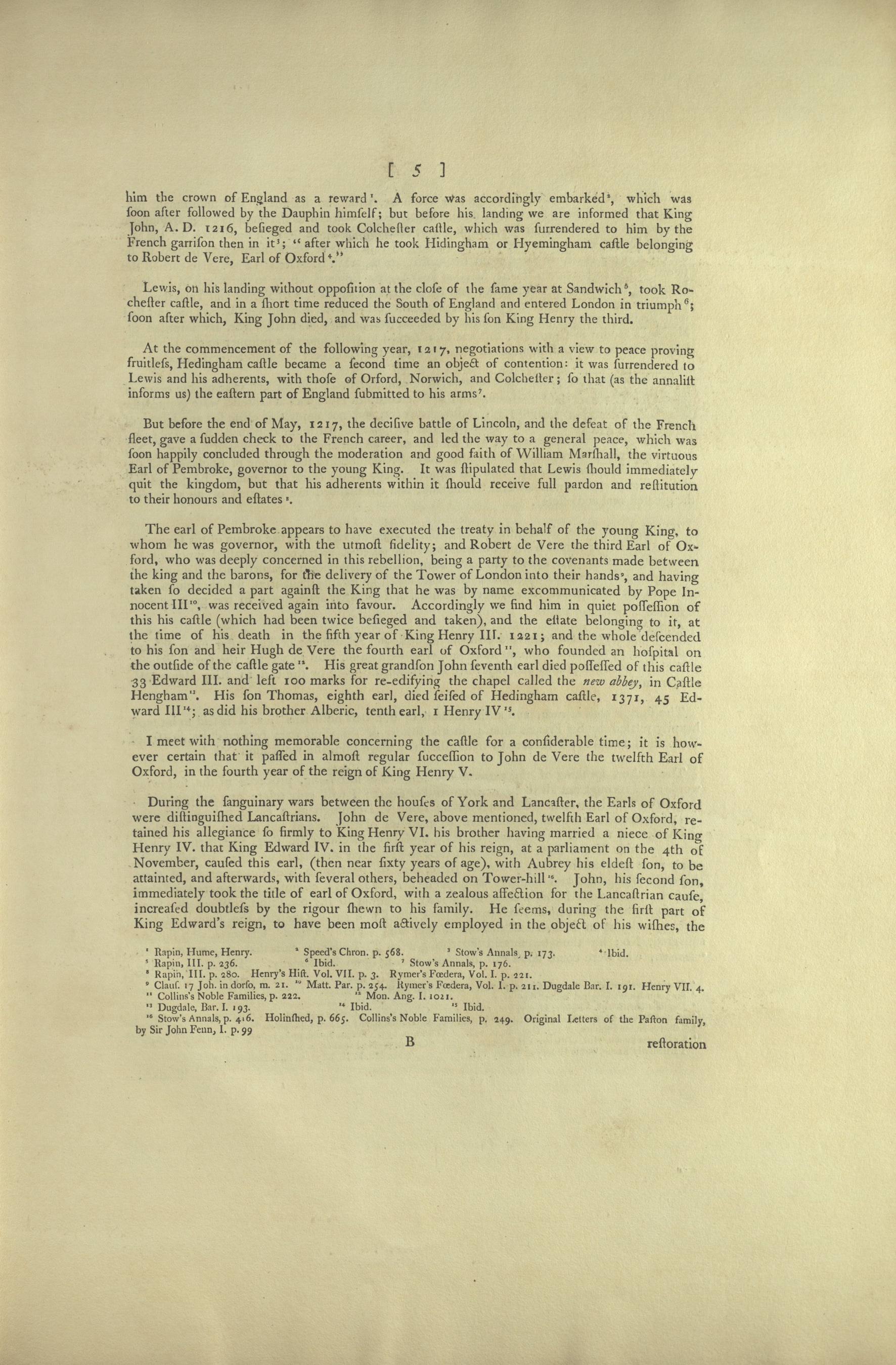
[ (Page) 5 ]
him the crown of England as a reward1. A force was accordingly embarked2, which was soon after followed by the Dauphin himself; but before his landing we are informed that King John, A. D. 1216, besieged and took Colchester castle, which was surrendered to him by the French garrison then in it3; “after which he took Hidingham or Hyemingham castle belonging to Robert de Vere, Earl of Oxford4.”
Read more/less…
Lewis, on his landing without opposition at the close of the same year at Sandwich5 , took Rochester castle, and in a short time reduced the South of England and entered London in triumph6; soon after which, King John died, and was succeeded by his son King Henry the third.
At the commencement of the following year, 1217, negotiations with a view to peace proving fruitless, Hedingham castle became a second time an object of contention: it was surrendered to Lewis and his adherents, with those of Orford, Norwich, and Colchester; so that (as the annalist informs us) the eastern part of England submitted to his arms7.
But before the end of May, 1217, the decisive battle of Lincoln, and the defeat of the French fleet, gave a sudden check to the French career, and led the way to a general peace, which was soon happily concluded through the moderation and good faith of William Marshall, the virtuous Earl of Pembroke, governor to the young King. It was stipulated that Lewis should immediately quit the kingdom, but that his adherents within it should receive full pardon and restitution to their honours and estates8.
The earl of Pembroke appears to have executed the treaty in behalf of the young King, to whom he was governor, with the utmost fidelity; and Robert de Vere the third Earl of Oxford, who was deeply concerned in this rebellion, being a party to the covenants made between the king and the barons, for the delivery of the Tower of London into their hands9, and having taken so decided a part against the King that he was by name excommunicated by Pope Innocent III10, was received again into favour. Accordingly we find him in quiet possession of this his castle (which had been twice besieged and taken), and the estate belonging to it, at the time of his death in the fifth year of King Henry III. 1221; and the whole descended to his son and heir Hugh de Vere the fourth earl of Oxford11, who founded an hospital on the outside of the castle gate12. His great grandson John seventh earl died possessed of this castle 33 Edward III. and left 100 marks for re-edifying the chapel called the new abbey, in Castle Hengham13. His son Thomas, eighth earl, died seised of Hedingham castle, 1371, 45 Edward III14; as did his brother Alberic, tenth earl, I Henry IV15.
I meet with nothing memorable concerning the castle for a considerable time; it is however certain that it passed in almost regular succession to John de Vere the twelfth Earl of Oxford, in the fourth year of the reign of King Henry V.
During the sanguinary wars between the houses of York and Lancaster, the Earls of Oxford were distinguished Lancastrians. John de Vere, above mentioned, twelfth Earl of Oxford, retained his allegiance so firmly to King Henry VI. his brother having married a niece of King Henry IV. that King Edward IV. in the first year of his reign, at a parliament on the 4th of November, caused this earl, (then near sixty years of age), with Aubrey his eldest son, to be attainted, and afterwards, with several others, beheaded on Tower-hill16. John, his second son, immediately took the title of earl of Oxford, with a zealous affection for the Lancastrian cause, increased doubtless by the rigour shewn to his family. He seems, during the first part of King Edward’s reign, to have been most actively employed in the object of his wishes, the
1Rapin, Hume Henry.
2Speed’s Chron. P. 568.
3Stow’s Annals p. 173
4Ibid.
5Rapin, III. p. 236.
6Ibid.
7Stow’s Annals, p. 176.
8Rapin, III. p. 280. Henry’s Hist. Vol. VII. p. 3. Rymer’s Foedera, Vol. I. p. 221.
9Claus. 17 Joh. in dorso, m. 21.
10Matt. Par. p. 254. Rymer’s Foedera, Vol. I. p. 211. Dugdale Bar. I. 191. Henry VII. 4.
11Collins’s Noble Families, p. 222.
12Mon. Ang. I. 1021.
13Dugdale, Bar. I. 193.
14Ibid.
15Ibid.
16Stow’s Annals, p. 416. Holinshed, p. 665. Collins’s Noble Families, p. 249. Original Letters of the Paston family, by Sir Jon Fenn, I. p. 99
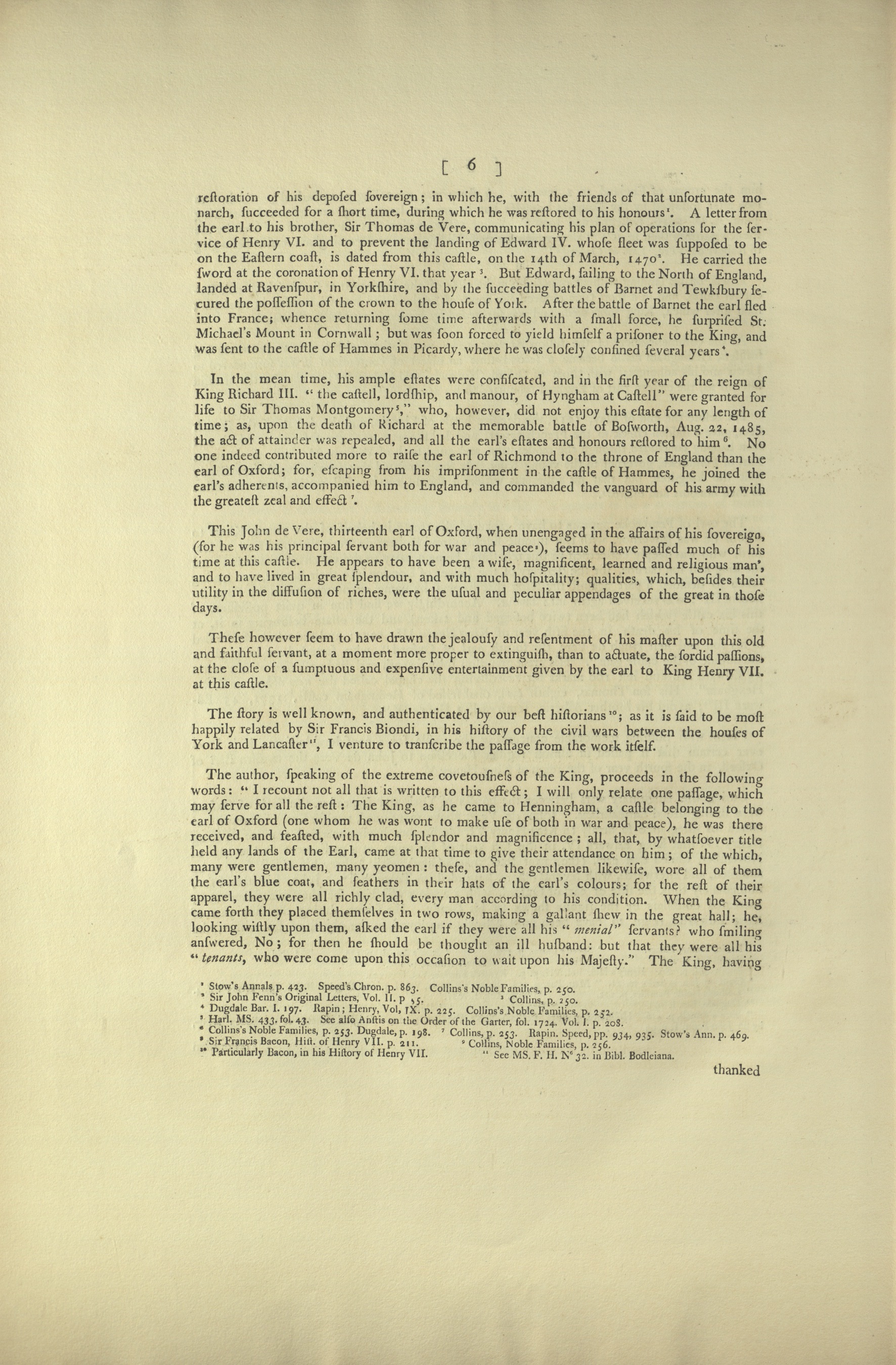
[ (Page) 6 ]
restoration of his deposed sovereign; in which he, with the friends of that unfortunate monarch, succeeded for a short time, during which he was restored to his honours1. A letter from the earl to his brother, Sir Thomas de Vere, communicating his plan of operations for the service of Henry VI. and to prevent the landing of Edward IV. whose fleet was supposed to be on the Eastern coast, is dated from this castle, on the 14th of March, 14702.
Read more/less…He carried the sword at the coronation of Henry VI. that year3. But Edward, sailing to the North of England, landed at Ravenspur, in Yorkshire, and by the succeeding battles of Barnet and Tewksbury secured the possession of the crown to the house of York. After the battle of Barnet the earl fled into France; whence returning some time afterwards with a small force, he surprised St. Michael’s Mount in Cornwall; but was soon forced to yield himself a prisoner to the King, and was sent to the castle of Hammes in Picardy, where he was closely confined several years4.
In the mean time, his ample estates were confiscated, and in the first year of the reign of King Richard III. “the castell, lordship, and manour, of Hyngham at Castell” were granted for life to Sir Thomas Montgomery5,” who, however, did not enjoy the estate for any length of time; as, upon the death of Richard at the memorable battle of Bosworth, Aug. 22, 1485, the act of attainder was repealed, and all the earl’s estates and honours restored to him6. No one indeed contributed more to raise the earl of Richmond to the throne of England than the earl of Oxford; for, escaping from his imprisonment in the castle of Hammes, he joined the earl’s adherents, accompanied him to England, and commanded the vanguard of his army with the greatest zeal and effect7.
This John de Vere, thirteenth earl of Oxford, when unengaged in the affairs of his sovereign, (for he was his principal servant both for war and peace8), seems to have passed much of his time at this castle. He appears to have been a wise, magnificent, learned and religious man9, and to have lived in great splendour, and with much hospitality; qualities, which, besides their utility in the diffusion of riches, were the usual and peculiar appendages of the great in those days.
These however seem to have drawn the jealousy and resentment of his master upon this old and faithful servant, at a moment more proper to extinguish, than to actuate, the sordid passions, at the close of a sumptuous and expensive entertainment given by the earl to King Henry VII. at this castle.
The story is well known, and authenticated by our best historians10; as it is said to be most happily related by Sir Francis Biondi, in his history of the civil wars between the houses of York and Lancaster11, I venture to transcribe the passage from the work itself.
The author, speaking of the extreme covetousness of the King, proceeds in the following words: “I recount not all that is written to this effect; I will only relate one passage, which may serve for all the rest: The King, as he came to Henningham, a castle belonging to the earl of Oxford (one whom he was wont to make use of both in war and peace), he was there received, and feasted, with much splendor and magnificence; all, that, by whatsoever title held any lands of the Earl, came at that time to give their attendance on him; of the which, many were gentlemen, many yeomen: these, and the gentlemen likewise, wore all of them the earl’s blue coat, and feathers in their hats of the earl’s colours; for the rest of their apparel, they were all richly clad, every man according to his condition. When the King came forth they placed themselves in two rows, making a gallant shew in the great hall; he, looking wistly upon them, asked the earl if they were all his “menial” servants? who smiling answered, No; for then he should be thought an ill husband: but that they were all his “tenants, who were come upon this occasion to wait upon his Majesty.” The King, having
1Stow’s Annals p. 423. Speed’s Chron. P. 863. Collin’s Noble Families, p. 250.
2Sir John Fenn’s Original Letters, Vol. II. p 55
3Collins, p. 250.
4Dugdale Bar. I. 197. Rapin; Henry, Vol, IX. p. 225. Collins’s Noble Families, p. 252.
5Harl. MS. 433. Fol. 43. See also Anstis on the Order of the Garter, fol. 1724. Vol. I. p. 208.
6Collins’s Noble Families, p. 253. Dugdale, p. 198.
7Collins, p. 253. Rapin. Speed, pp. 934, 935. Stow’s Ann. P. 469.
8Sir Francis Bacon, Hist. of Henry VII. p. 211.
9Collins, Noble Families, p. 256.
10Particularly Bacon, in his History of Henry VII.
11See MS. F. H. No 32. in Bibl. Bodleiana.
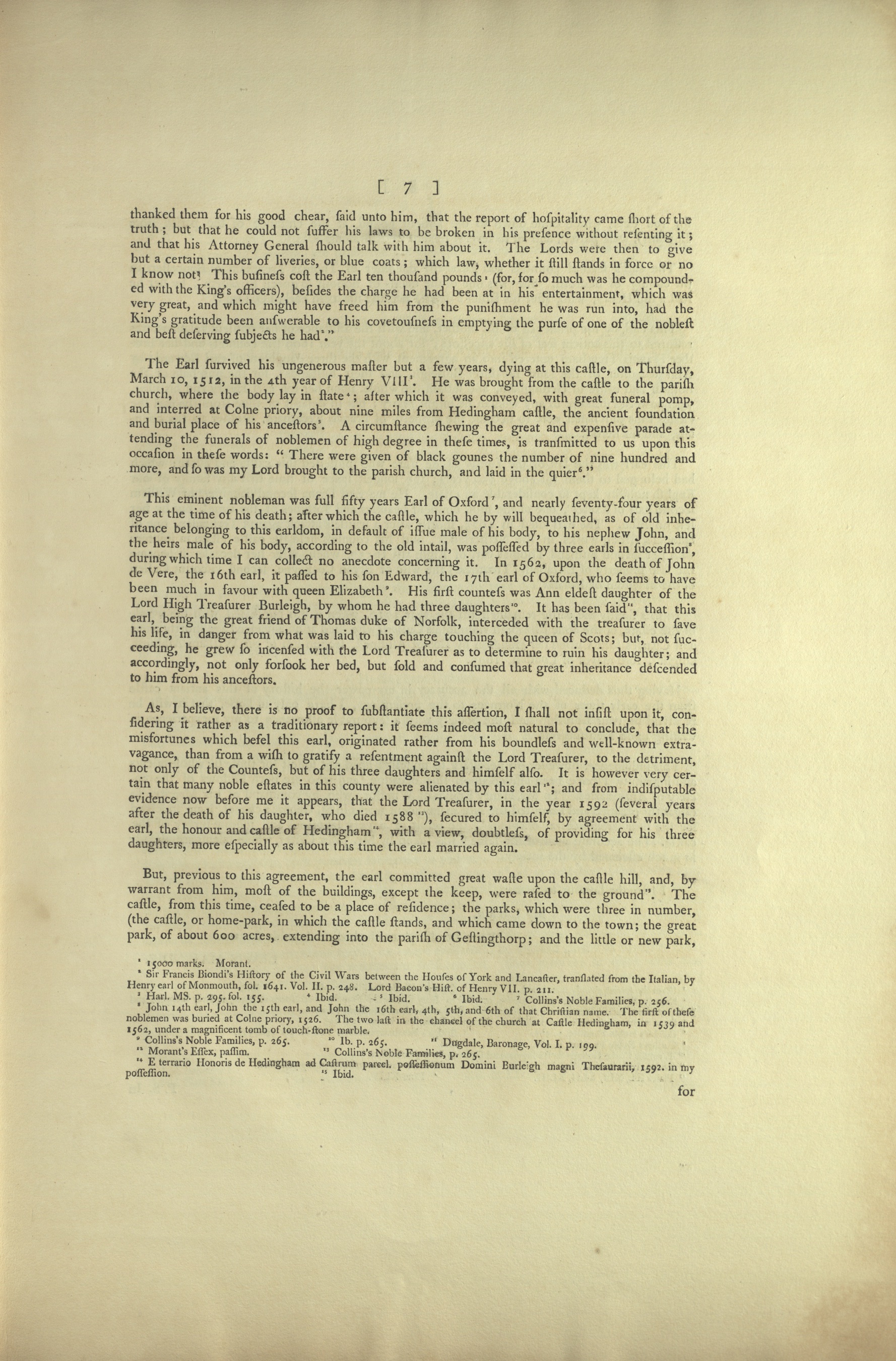
[ (Page) 7 ]
thanked them for his good chear, said unto him, that the report of hospitality came short of the truth; but that he could not suffer his laws to be broken in his presence without resenting it; and that his Attorney General should talk with him about it. The Lords were then to give but a certain number of liveries, or blue coats; which law, whether it stills stands in force or no I know not[.]
Read more/less…This business cost the Earl ten thousand pounds1 (for, for so much was he compounded with the King’s officers), besides the charge he had been at in his entertainment, which was very great, and which might have freed him from the punishment he was run into, had the King’s gratitude been answerable to his covetousness in emptying the purse of one of the noblest and best deserving subjects he had2.”
The Earl survived his ungenerous master but a few years, dying at this castle, on Thursday, March 10, 1512, in the 4th year of Henry VIII3. He was brought from the castle to the parish church, where the body lay in state4; after which it was conveyed, with great funeral pomp, and interred at Colne priory, about nine miles from Hedingham castle, the ancient foundation and burial place of his ancestors5. A circumstance shewing the great and expensive parade attending the funerals of noblemen of high degree in these times, is transmitted to us upon this occasion in these words: “There were given of black gounes the number of nine hundred and more, and so was my Lord brought to the parish church, and laid in the quier6.”
This eminent nobleman was full fifty years Earl of Oxford7, and nearly seventy-four years of age at the time of his death; after which the castle, which he by will bequeathed, as of old inheritance belonging to this earldom, in default of issue male of his body, to his nephew John, and the heirs male of his body, according to the old intail, was possessed by three earls in succession8, during which time I can collect no anecdote concerning it. In 1562, upon the death of John de Vere, the 16th earl, it passed to his son Edward, the 17th earl of Oxford, who seems to have been much in favour with queen Elizabeth9. His first countess was Ann eldest daughter of the Lord High Treasurer Burleigh, by whom he had three daughers10. It has been said11, that this earl, being the great friend of Thomas duke of Norfolk, interceded with the treasurer to save his life, in danger from what was laid to his charge touching the queen of Scots; but, not succeeding, he grew so incensed with the Lord Treasurer as to determine to ruin his daughter; and accordingly, not only forsook her bed, but sold and consumed that great inheritance descended to him from his ancestors.
As, I believe, there is no proof to substantiate this assertion, I shall not insist upon it, considering it rather as a traditionary report: it seems indeed most natural to conclude, that the misfortunes which befel this earl, originated rather from his boundless and well-known extravagance, than from a wish to gratify a resentment against the Lord Treasurer, to the detriment, not only of the Countess, but of his three daughters and himself also. It is however very certain that many noble estates in this county were alienated by this earl12; and from indisputable evidence now before me it appears, that the Lord Treasurer, in the year 1592 (several years after the death of his daughter, who died 158813), secured to himself, by agreement with the earl, the honour and castle of Hedingham14, with a view, doubtless, of providing for his three daughters, more especially as about this time the earl married again.
But, previous to this agreement, the earl committed great waste upon the castle hill, and, by warrant from him, most of the buildings, except the keep, were rased to the ground15. The castle, from this time, ceased to be a place of residence; the parks, which were three in number, (the castle, or home-park, in which the castle stands, and which came down to the town; the great park, of about 600 acres, extending into the parish of Gestingthrop; and the little or new park,
115000 marks. Morant.
2Sir Francis Biondi’s History of the Civil Wars between the Houses of York and Lancaster, translated from the Italian, by Henry earl of Monmouth, fol. 1641. Vol. II. p. 248. Lord Bacon’s Hist. of Henry VII. p. 211.
3Harl. MS. p.295. fol. 155.
4Ibid.
5Ibid.
6Ibid.
7Collins’s Noble Families, p. 256.
8John 14th earl, John the 15th earl, and John the 16th earl, 4th, 5th, and 6th of that Christian name. The first of these noblemen was buried at Colne priory, 1526. The two last in the chancel of the church at Castle Hedingham, in 1539 and 1562, under a magnificent tomb of touch-stone marble.
9Collins’s Noble Families, p. 265.
10Ib. p. 265.
11Dugdale, Baronage, Vol. I. p. 199.
12Morant’s Essex, passim.
13Collins’s Noble Families, p. 265.
14E terrario Honoris de Hedingham ad Castrum parcel. possessionum Domini Burleigh magni Thesaurarii, 1592. in my possession.
15Ibid.
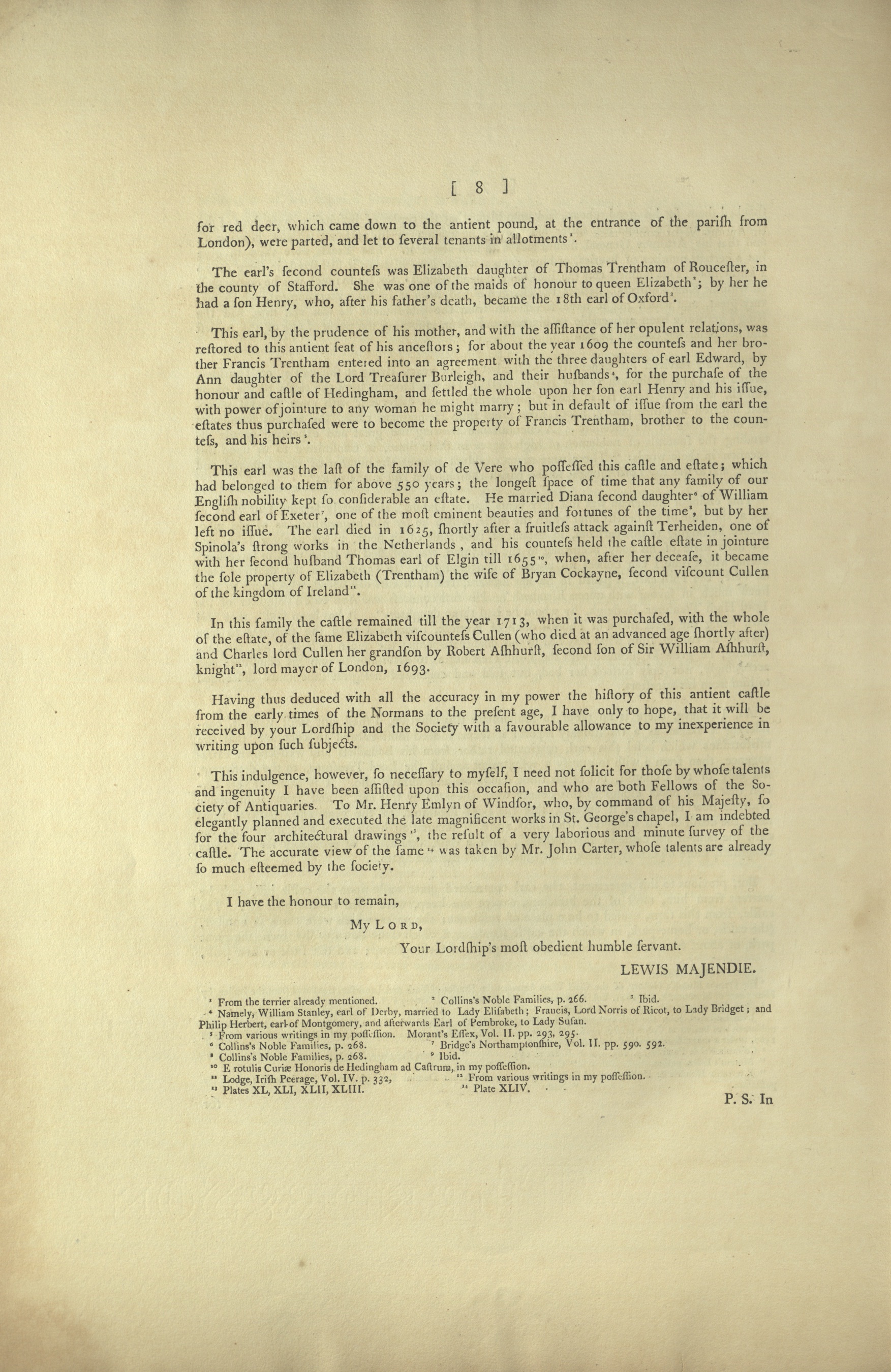
[ (Page) 8 ]
for red deer, which came down to the antient pound, at the entrance of the parish from London), were parted, and let to several tenants in allotments1.
The earl’s second countess was Elizabeth daughter of Thomas Trentham of Roucester, in the county of Stafford. She was one of the maids of honour to queen Elizabeth2; by her he had a son Henry, who, after his father’s death, became the 18th earl of Oxford3.
Read more/less…
This earl, by the prudence of his mother, and with the assistance of her opulent relations, was restored to this antient seat of his ancestors; for about the year 1609 the countess and her brother Francis Trentham entered into an agreement with the three daughters of earl Edward, by Ann daughter of the Lord Treasurer Burleigh, and their husbands4, for the purchase of the honour and castle of Hedingham, and settled the whole upon her son earl Henry and his issue, with power of jointure to any woman he might marry; but in default of issue from the earl the estates thus purchased were to become the property of Francis Trentham, brother to the countess, and his heirs5.
This earl was the last of the family of de Vere who possessed this castle and estate; which had belonged to them for above 550 years; the longest space of time that any family of our English nobility kept so considerable an estate. He married Diana second daughter6 of William second earl of Exeter7, one of the most eminent beauties and fortunes of the time8, but by her left no issue. The earl died in 1625, shortly after a fruitless attack against Terheiden, one of Spinola’s strong works in the Netherlands, and his countess held the castle estate in jointure with her second husband Thomas earl of Elgin till 169510, when, after her decease, it became the sole property of Elizabeth (Trentham) the wife of Bryan Cockayne, second viscount Cullen of the kingdom of Ireland11.
In this family the castle remained till the year 1713, when it was purchased, with the whole of the estate, of the same Elizabeth viscountess Cullen (who died at an advanced age shortly after) and Charles lord Cullen her grandson by Robert Ashhurst, second son of Sir William Ashhurst, knight12, lord mayor of London, 1693.
Having thus deduced with all the accuracy in my power the history of this antient castle from the early times of the Normans to the present age, I have only to hope, that it will be received by your Lordship and the Society with a favourable allowance to my inexperience in writing upon such subjects.
This indulgence, however, so necessary to myself, I need not solicit for those by whose talents and ingenuity I have been assisted upon this occasion, and who are both Fellows of the Society of Antiquaries. To Mr. Henry Emlyn of Windsor, who, by command of his Majesty, so elegantly planned and executed the late magnificent works in St. George’s chapel, I am indebted for the four architectural drawings13, the result of a very laborious and minute survey of the castle. The accurate view of the same14 was taken by Mr. John Carter, whose talents are already so much esteemed by the society.
I have the honour to remain,
My LORD,
Your Lordship’s most obedient humble servant.
LEWIS MAJENDIE.
1From the terrier already mentioned.
2Collins’s Noble Families, p. 266.
3Ibid.
4Namely, William Stanley, earl of Derby, married to Lady Elisabeth; Francis, Lord Norris of Ricot, to Lady Bridget; and Philip Herbert, earl of Montgomery, and afterwards Earl of Pembroke, to Lady Susan.
5From various writings in my possession. Morant’s Essex, Vol. II. p. 293. 295.
6Collins’s Noble Families, p. 268.
7Bridge’s Northamptonshire, Vol. II. pp. 590. 592.
8Collins’s Noble Families, p. 268.
9Ibid. [this footnote not found in body of original text]
10E rotulis Curiae Honoris de Hedingham ad Castrum, in my possession.
11Lodge, Irish Peerage, Vol. IV. p. 332[.]
12From various writings in my possession.
13Plates XL, XLI, XLII, XLIII.
14Plate XLIV.
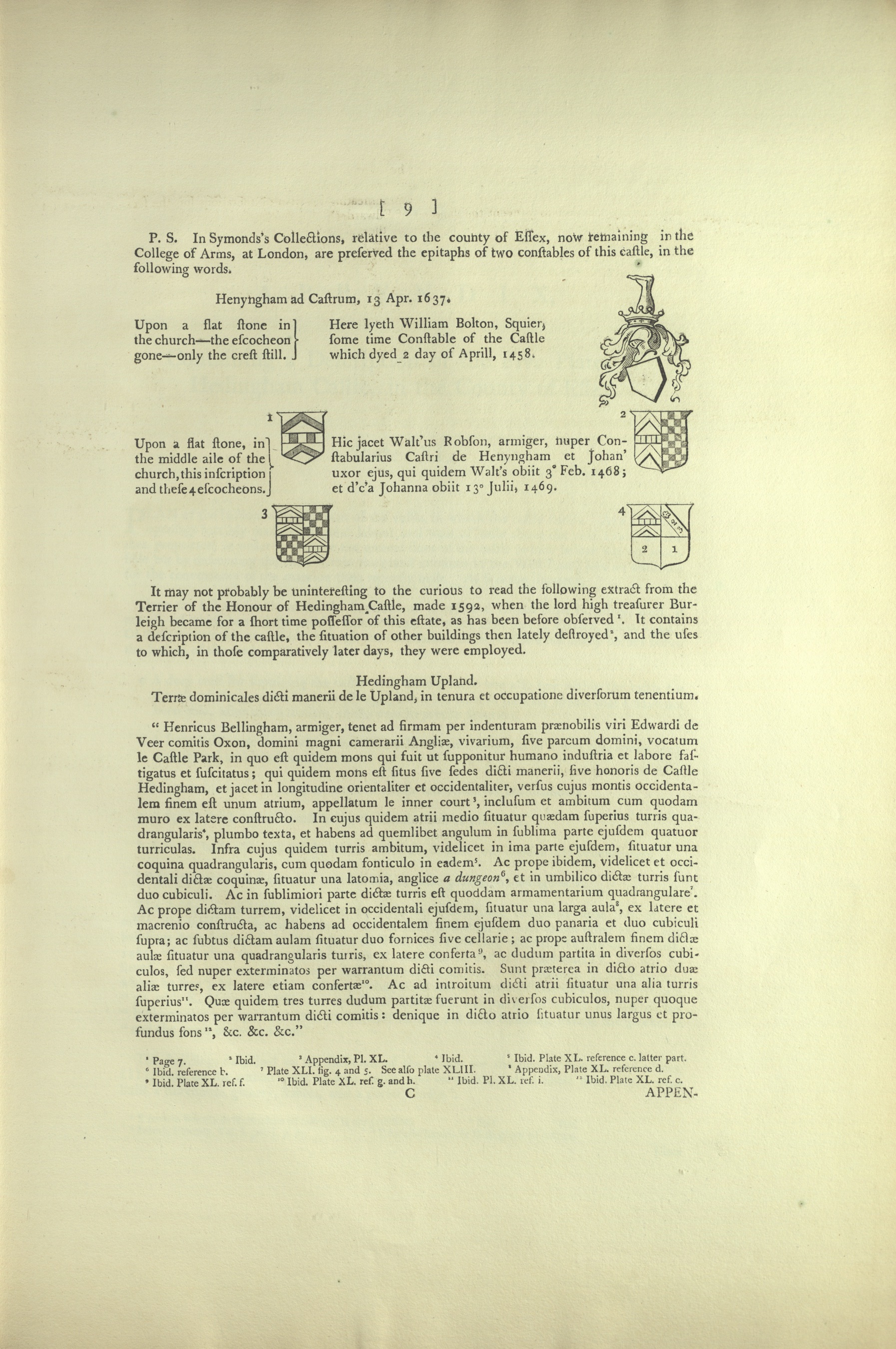
[ (Page) 9 ]
P. S. In Symonds’s Collections, relative to the county of Essex, now remaining in the College of Arms, at London, are preserved the epitaphs of two constables of this castle, in the following words.
Read more/less…[Scroll down to view the rest of the transcription for this page. P. 10 is blank in the original.]
Henyngham ad Castrum, 13 Apr. 1637.
Upon a flat stone in Here lyeth William Bolton, Squier,
the church—the escocheon some time Constable of the Castle
gone—only the crest still. which dyed a day of Aprill, 1458.
[To the right is a representation of the escutcheon.]
Upon a flat stone, in Hic jacet Walt’us Robson, armiger, nuper Con-
the middle aile of the stabularius Castri de Henyngham et Johan’
church, this inscription uxor ejus, qui quidem Walt’s obit 3o Feb. 1468;
and these 4 escocheons. et d’c’a Johanna obit 13o Julii, 1469.
[Here lies Walter Robson, arms-bearer, late Constable of the Castle of Hedingham, and his wife Johanna; this Walter died 3rd Feb. 1468, and the said Johanna died 13th July, 1469.]
[Throughout are depicted four escutcheons.]
It may not probably be uninteresting to the curious to read the following extract from the Terrier of the Honour of Hedingham Castle, made 1592, when the lord high treasurer Burleigh became for a short time possessor of this estate, as has been before observed1. It contains a description of the castle, the situation of other buildings then lately destroyed2, and the uses to which, in those comparatively later days, they were employed.
Hedingham Upland.
Terrae dominicales dicti manerii de le Upland, in tenure et occupatione diversorum tenentium. [Demesne lands of said manner in the Upland, on the tenure and occupation of various tenents.]
“Henricus Bellingham, armiger, tenet ad firmam per indenturam praenobilis viri Edwardi de Veer comitis Oxon, domini magni camerarii Angliae, vivarium, sive parcum domini, vocatum le Castle Park, in quo est quidem mons qui fuit ut supponitur humano industria et labore fastigatus et suscitatus; qui quidem mons est situs sive sedes dicti manerii, sive honoris de Castle Hedingham, et jacet in longitudine orientaliter et occidentaliter, versus cujus montis occidentalem finem est unum atrium, appellatum le inner court3, inclusum et ambitum cum quodam muro ex latere constructo. In cujus quidem atrii medio situatur quaedam superius turris quadrangularis4, plumbo texta, et habens ad quemlibet angulum in sublima parte ejusdem quatuor turriculas. Infra cujus quidem turris ambitum, videlicet in ima parte ejusdem, situatur una coquina quadrangularis, cum quodam fonticulo in eadem5. Ac prope ibidem, videlicet et occidentali dictae coquinae, situatur una latomia, anglice a dungeon6, et in umbilico dictae turris sunt duo cubiculi. Ac in sublimiori parte dictae turris est quoddam armamentarium quadrangulare7. Ac prope dictam turrem, videlicet in occidentali ejusdem, situatur una larga aula8, ex latere et macrenio constructa, ac habens ad occidentalem finem ejusdem duo panaria et duo cubiculi supra; ac subtus dictam aulam situatur duo fornices sive cellarie; ac prope australem finem dictae aulae situatur una quadrangularis turris, ex latere confertae9, ac dudum partita in diversos cubiculos, sed nuper exterminatos per warrantum dicti comitis. Sunt praeterea in dicto atrio duae aliae turres, ex latere etiam confertae10. Ac ad introitum dicti atrii situatur una alia turris superius11. Quae quidem tres turres dudum partitae fuerunt in diversos cubiculos, nuper quoque exterminatos per warrantum dicti comitis: denique in dicto atrio situatur unus largus et profundus fons12, &c. &c. &c.”
[See end of document for translation. Account continues with Appendix on p. 11.]
1Page 7.
2Ibid.
3Appendix, Pl. XL.
4Ibid.
5Ibid. Plate XL. reference c. latter part.
6Ibid. reference b.
7Plate XLI. fig. 4 and 5. See also plate XLIII.
8Appendix, Plate XL. reference d.
9Ibid. Plate XL. ref. f.
10Ibid. Plate XL. ref. g. and h.
11Ibid. Pl. XL. ref. i.
12Ibid. Plate XL. ref. c.
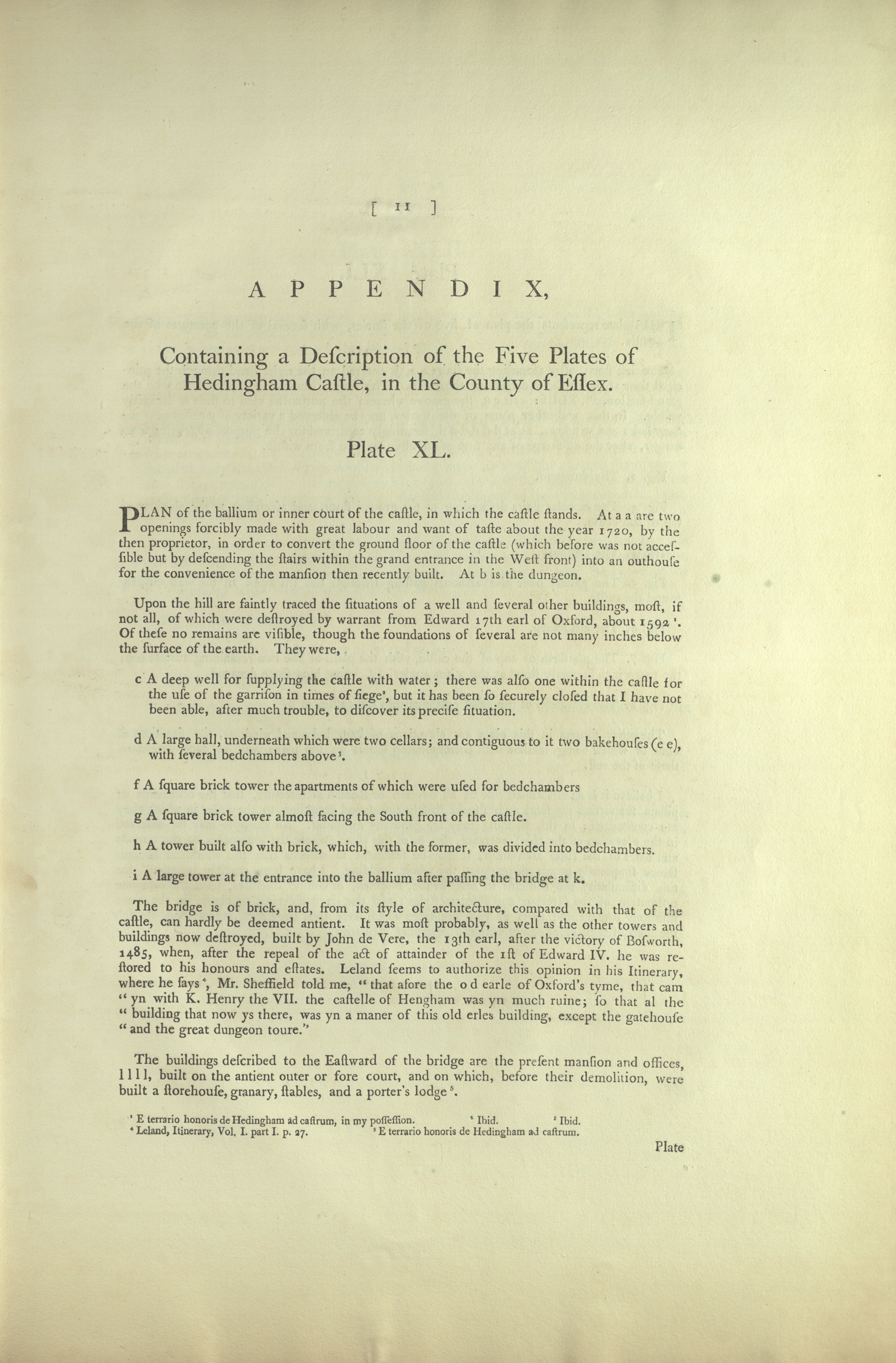
[(Page) 11 ]
A P P E N D I X,
Containing a Description of the Five Plates of Hedingham Castle, in the County of Essex.
Plate XL.
PLAN of the ballium or inner court of the castle, in which the castle stands. At a a are two openings forcibly made with great labour and want of taste about the year 1720, by the then proprietor, in order to convert the ground floor of the castle (which before was not accessible but by descending the stairs within the grand entrance in the West front) into an outhouse for the convenience of the mansion then recently built. At b is the dungeon.
Read more/less…
Upon the hill are faintly traced the situations of a well and several other buildings, most, if not all, of which were destroyed by warrant from Edward 17th earl of Oxford, about 15921. Of these no remains are visible, though the foundations of several are not many inches below the surface of the earth. They were,
c A deep well for supplying the castle with water; there was also one within the castle for the use of the garrison in times of siege2, but it has been so securely closed that I have not been able, after much trouble, to discover its precise situation.
d A large hall, underneath which were two cellars; and contiguous to it two bakehouses (e e), with several bedchambers above3.
f A square brick tower the apartments of which were used for bedchambers[.]
g A square brick tower almost facing the South front of the castle.
h A tower built also with brick, which, with the former, was divided into bedchambers.
i A large tower at the entrance into the ballium after passing the bridge at k.
The bridge is of brick, and, from its style of architecture, compared with that of the castle, can hardly be deemed antient. It was most probably, as well as the other towers and buildings now destroyed, built by John de Vere, the 13th earl, after the victory of Bosworth, 1485, when, after the repeal of the act of attainder of the 1st of Edward IV. he was restored to his honours and estates. Leland seems to authorize this opinion in his Itinerary, where he says4, Mr. Sheffield told me, “that afore the [old] earle of Oxford’s tyme, that cam yn with K. Henry the VII. the castelle of Hengham was yn much ruine; so that al the building that now ys there, was yn a maner of this old erles building, except the gatehouse and the great dungeon toure.”
The buildings described to the Eastward of the bridge are the present mansion and offices, l l l l, built on the antient outer or fore court, and on which, before their demolition, were built a storehouse, granary, stables, and a porter’s lodge5.
1E terrario honoris de Hedingham ad castrum [translation to be completed], in my possession.
2Ibid.
3Ibid.
4Leland, Itinerary, Vol. I. part I. p. 27.
5E terrario honoris de Hedingham ad castrum.
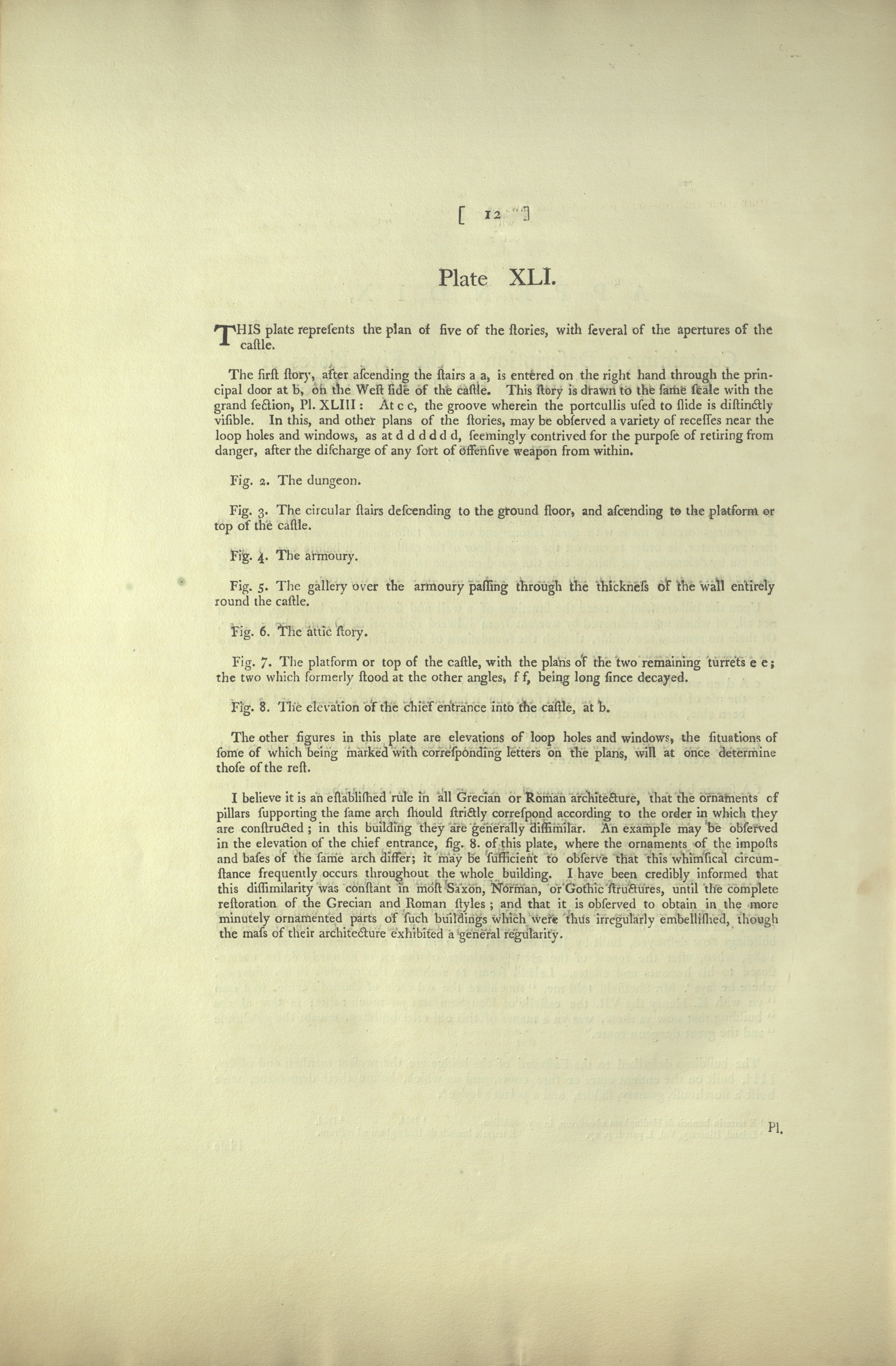
[ (Page) 12 ]
Plate XLI.
THIS plate represents the plan of five of the stories, with several of the apertures of the castle.
The first story, after ascending the stairs a a, is entered on the right hand through the principal door at b, on the West side of the castle. This story is drawn to the same scale with the grand section, Pl. XLIII: At c c, the groove wherein the portcullis used to slide is distinctly visible. In this, and other plans of the stories, may be observed a variety of recesses near the loop holes and windows, as at d d d d d d, seemingly contrived for the purpose of retiring from danger, after the discharge of any sort of offensive weapon from within.
Read more/less…
Fig. 2. The dungeon.
Fig. 3. The circular stairs descending to the ground floor, and ascending to the platform or top of the castle.
Fig. 4. The armoury.
Fig. 5. The gallery over the armoury passing through the thickness of the wall entirely round the castle.
Fig. 6. The attic story.
Fig. 7. The platform or top of the castle, with the plans of the two remaining turrets e e; the two which formerly stood at the other angles, f f, being long since decayed.
Fig. 8. The elevation of the chief entrance into the castle, at h.
The other figures in this plate are elevations of loop holes and windows, the situation of some of which being marked with corresponding letters on the plans, will at once determine those of the rest.
I believe it is an established rule in all of Grecian or Roman architecture, that the ornaments of pillars supporting the same arch should strictly correspond according to the order in which they are constructed; in this building they are generally dissimilar. An example may be observed in the elevation of the chief entrance, fig. 8. of this plate, where the ornaments of the imposts and bases of the same arch differ; it may be sufficient to observe that this whimsical circumstance frequently occurs throughout the whole building. I have been credibly informed that this dissimilarity was constant in most Saxon, Norman, or Gothic structures, until the complete restoration of the Grecian and Roman styles; and that it is observed to obtain in the more minutely ornamented parts of such buildings which were thus irregularly embellished, though the mass of their architecture exhibited a general regularity.
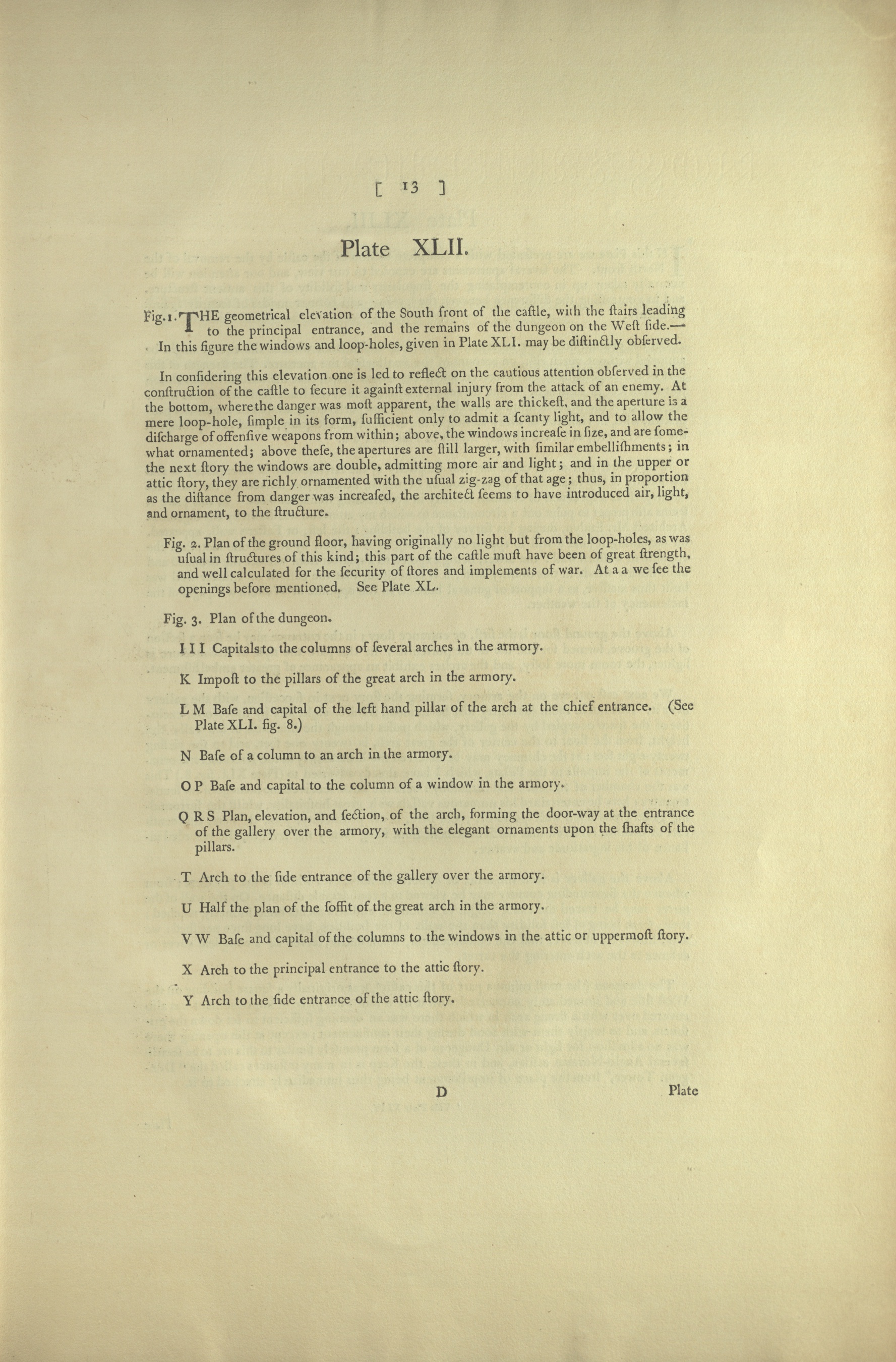
[ (Page) 13 ]
Plate XLII.
Fig. 1. THE geometrical elevation of the South front of the castle, with the stairs leading to the principal entrance, and the remains of the dungeon on the West side.—In this figure the windows and loop-holes, given in Plate XLI. may be distinctly observed.
Read more/less…
In considering this elevation one is led to reflect on the cautious attention observed in the construction of the castle to secure it against external injury from the attack of an enemy. At the bottom, where the danger was most apparent, the walls are thickest, and the aperture is a mere loop-hole, simple in its form, sufficient only to admit a scanty light, and to allow the discharge of offensive weapons from within; above, the windows increase in size, and are somewhat ornamented; above these, the apertures are still larger, with similar embellishments; in the next story the windows are double, admitting more air and light; and in the upper or attic story, they are richly ornamented with the usual zig-zag of that age; thus, in proportion as the distance from danger was increased, the architect seems to have introduced air, light, and ornament, to the structure.
Fig. 2. Plan of the ground floor, having originally no light but from the loop-holes, as was usual in structures of this kind; this part of the castle must have been of great strength, and well calculated for the security of stores and implements of war. At a a we see the openings before mentioned. See Plate XL.
Fig. 3. Plan of the dungeon.
I I I Capitals to the columns of several arches in the armory.
K Impost to the pillars of the great arch in the armory.
L M Base and capital of the left hand pillar of the arch at the chief entrance. (See Plate XLI. fig. 8.)
N Base of a column to an arch in the armory.
O P Base and capital to the column of a window in the armory.
Q R S Plan, elevation, and section, of the arch, forming the door-way at the entrance of the gallery over the armory, with the elegant ornaments upon the shafts of the pillars.
T Arch to the side entrance of the gallery over the armory.
U Half the plan of the soffit of the great arch in the armory.
V W Base and capital of the columns to the windows in the attic or uppermost story.
X Arch to the principal entrance to the attic story.
Y Arch to the side entrance of the attic story.
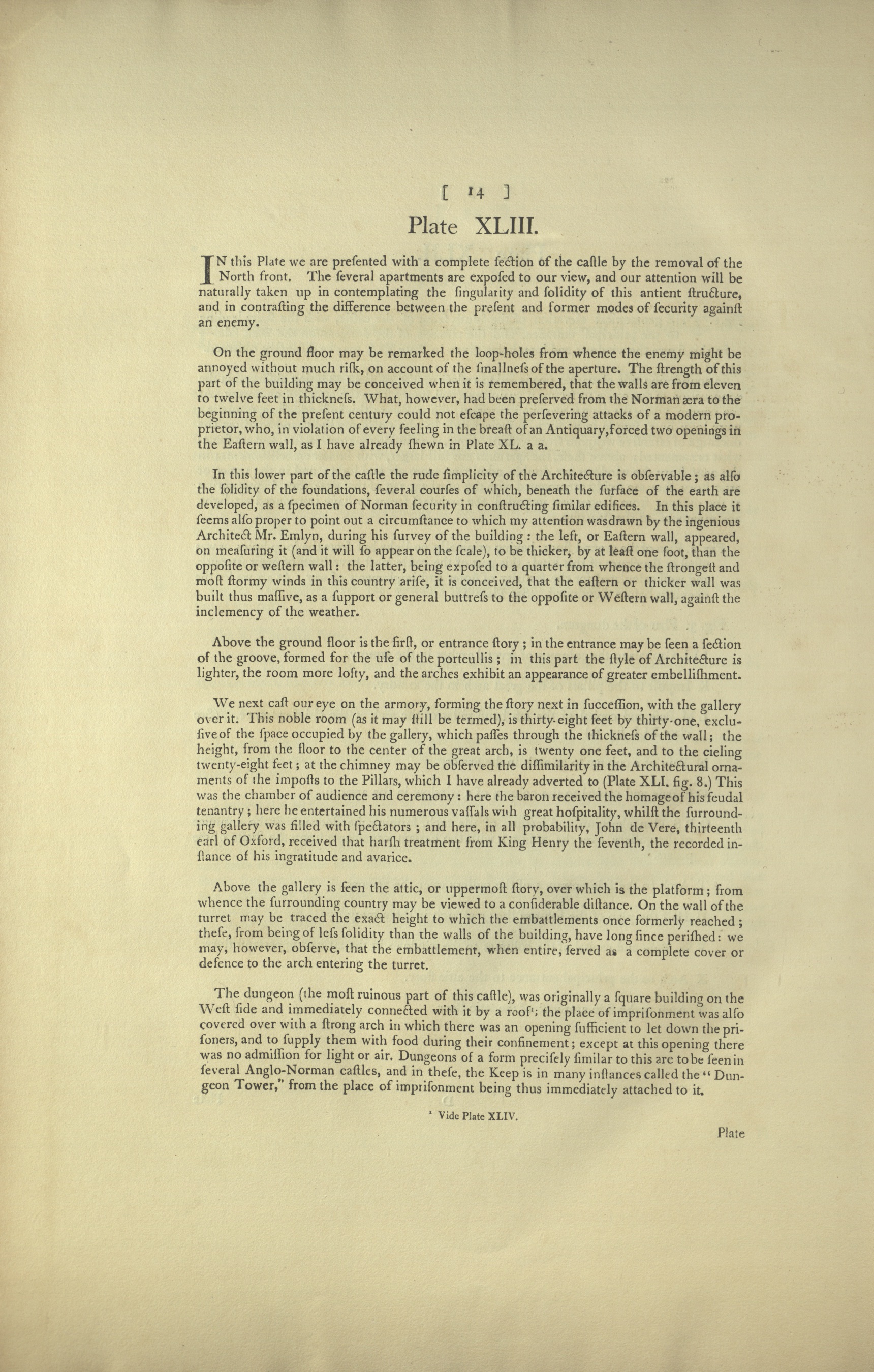
[ (Page) 14 ]
Plate XLIII.
IN this Plate we are presented with a complete section of the castle by the removal of the North front. The several apartments are exposed to our view, and our attention will be naturally taken up in contemplating the singularity and solidity of this antient structure, and in contrasting the difference between the present and former modes of security against an enemy.
Read more/less…
On the ground floor may be remarked the loop-holes from whence the enemy might be annoyed without much risk, on account of the smallness of the aperture. The strength of this part of the building may be conceived when it is remembered, that the walls are from eleven to twelve feet in thickness. What, however, had been preserved from the Norman aera to the beginning of the present century could not escape the persevering attacks of a modern proprietor, who, in violation of every feeling in the breast of an Antiquary, forced two openings in the Eastern wall, as I have already shewn in Plate XL. a a.
In this lower part of the castle the rude simplicity of the Architecture is observable; as also the solidity of the foundations, several courses of which, beneath the surface of the earth are developed, as a specimen of Norman security in constructing similar edifices. In this place it seems also proper to point out a circumstance to which my attention [was drawn] by the ingenious Architect Mr. Emlyn, during his survey of the building: the left, or Eastern wall, appeared, on measuring it (and it will so appear on the scale), to be thicker, by at least one foot, than the opposite or western wall: the latter, being exposed to a quarter from whence the strongest and most stormy winds in this country arise, it is conceived, that the eastern or thicker wall was built thus massive, as a support or general buttress to the opposite or Western wall, against the inclemency of the weather.
Above the ground floor is the first, or entrance story; in the entrance may be seen a section of the groove, formed for the use of the portcullis; in this part the style of Architecture is lighter, the room more lofty, and the arches exhibit an appearance of greater embellishment.
We next cast our eye on the armory, forming the story next in succession, with the gallery over it. This noble room (as it may still be termed), is thirty-eight feet by thirty-one, exclusive of the space occupied by the gallery, which passes through the thickness of the wall; the height, from the floor to the center of the great arch, is twenty one feet, and to the cieling twenty-eight feet; at the chimney may be observed the dissimilarity in the Architectural ornaments of the imposts to the Pillars, which I have already adverted to (Plate XLI. fig. 8.) This was the chamber of audience and ceremony: here the baron received the homage of his feudal tenantry; here he entertained his numerous vassals with great hospitality, whilst the surrounding gallery was filled with spectators; and here, in all probability, John de Vere, thirteenth earl of Oxford, received that harsh treatment from King Henry the seventh, the recorded instance of his ingratitude and avarice.
Above the gallery is seen the attic, or uppermost story, over which is the platform; from whence the surrounding country may be viewed to a considerable distance. On the wall of the turret may be traced the exact height to which the embattlements once formerly reached; these, from being of less solidity than the walls of the building, have long since perished: we may, however, observe, that the embattlement, when entire, served as a complete cover or defence to the arch entering the turret.
The dungeon (the most ruinous part of this castle), was originally a square building on the West side and immediately connected with it by a roof1; the place of imprisonment was also covered over with a strong arch in which there was an opening sufficient to let down the prisoners, and to supply them with food during their confinement; except at this opening there was no admission for light or air. Dungeons of a form precisely similar to this are to be seen in several Anglo-Norman castles, and in these, the Keep is in many instances called the “Dungeon Tower,” from the place of imprisonment being thus immediately attached to it.
1Vide Plate XLIV.
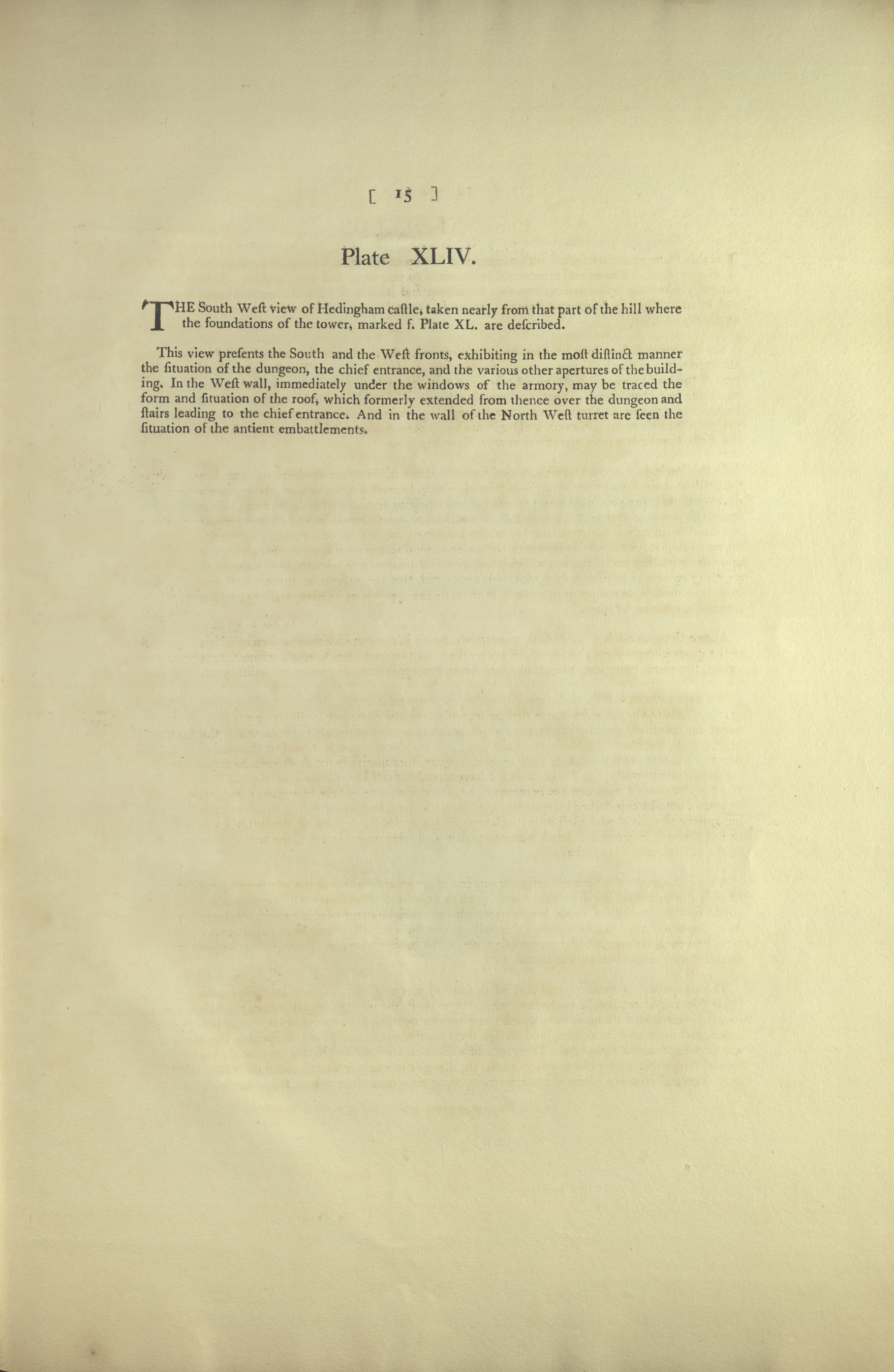
[ (Page) 15 ]
Plate XLIV.
THE South West view of Hedingham castle, taken nearly from that part of the hill where the foundations of the tower, marked f. Plate XL. are described.
This view presents the South and the West fronts, exhibiting in the most distinct manner the situation of the dungeon, the chief entrance, and the various other apertures of the building. In the West wall, immediately under the windows of the armory, may be traced the form and situation of the roof, which formerly extended from thence over the dungeon and stairs leading to the chief entrance. And in the wall of the North West turret are seen the situation of the antient embattlements.
Translation of the Longer Passage:
Page 9, lines 17-39: Henry Bellingham, arms-bearer, leases by indenture of the noble Edward de Veer, count of Oxford, great lord chamberlain of England, a vivarium, viz. the lord’s park, called Castle Park, in which there is a mound which, so it is supposed, was topped and raised with human effort and industry; this mound is the site and seat of said manor, viz. of the honour of Hedingham Castle, and lies on an east-west axis, on the east end of which mound there is an atrium, called the inner court, enclosed and surrounded by a brick wall. In the middle of this atrium is situated above a four-sided tower, lead-roofed, and having four little towers on each corner at their highest points. Below the perimeter of this tower, viz. at its base, is situated a four-sided kitchen with a well in it. And near there, viz. on the west side of the said kitchen, is situated a latomia, in English a dungeon, and in the center (lit. “navel”) of the tower there are two rooms. And on the upper part of the said tower is a four-sided armory. And near the said tower, viz, on its west side, is situated a forecourt, made of brick and mortar, and having on its western end two bakeries and two rooms above [them]. And under the said forecourt is situated two vaults or cellars; and near the southern end of the said forecourt is situated a four-sided tower, made of solid brick, [which] a while ago [had been] divided into different rooms but [whose] rooms [were] recently demolished by warrant of the said count. There are, besides, in the said atrium two other towers also made of solid brick. And at the entrance of the said atrium is situated another tower above. These three towers had been divided a while ago into different rooms, but recently [these rooms] were also demolished by warrant of the said count. Finally, in the said atrium is situated a large and deep well, etc., etc., etc.














